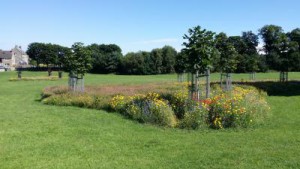
Although I have lived in Edinburgh for several years, and was a frequent visitor before that, I never really paid much attention to the green spaces that I passed. This traineeship has completely changed that, and has got me thinking about the value of urban green space and the role of parks in the urban ecosystem.
It is estimated that by 2030, 92% of the UK’s population will live in urban areas. This ever increasing urban population causes concern not only for the quality of life, but for the natural environment. Why, therefore, is it so important to protect and maintain urban Greenspace?
Benefits of urban greenspace
An urban green space network can make an important contribution to people’s quality of life, the conservation of biodiversity and in adapting to the adverse effects of climate change. It can also affect house prices, mental wellbeing, and air and water quality, carbon absorption and can provide natural flood defences and drainage – so not much then!
Urban greenspace can take many forms, from public parks to sports pitches, allotments to burial grounds. According to HLF (funders of many an urban greenspace scheme, and the Natural Networks training programme – thanks!), parks and greenspace are the most frequently used service of all municipal services. Yet parks can end up at the bottom of the agenda and many have been neglected, leaving a long list of management issues which are expensive to rectify. Thankfully the benefits of parks are now being recognised, and many friends groups have been set up to champion parks – in Edinburgh we have 40 such groups (out of 142 parks across the city). In light of budget cuts and staff shortages, these groups are invaluable for keeping community at the heart of parks.
There is still work to be done however to break away from the Victorian ideal of trees and short green grass. Ultimately, the more diverse the landscape, the better it is not just for wildlife but also for people. This however, requires educating people on the value of parks and diversity, which hopefully will also help to create a sense of ownership and stewardship. One of the many things that the Edinburgh Living Landscape aims to do is naturalise parks through relaxing grass cutting and sowing floral meadows, whilst also working with the community to direct and implement this change (You might have guessed it already, but that’s where I come in).
Green Development
When I’ve been talking to individuals about the Living Landscape initiative, the comment that keeps coming back is concern about development on green space. Unfortunately, we can’t always protect green space from development. But what we can do is incorporate green space and features for wildlife into development, so that all is not lost. The Edinburgh Living Landscape hopes to work with developers to incorporate green space into these new developments, so that they have green roofs, green walls and accessible community gardens for the residents.
A good example of what is possible can be found at Slateford Green in the south west of the city. I visited the community centre there during March for a community consultation about the redevelopment of nearby Saughton Park, and was impressed by the design and feel of the place – it is unlike any other building I have visited. This residential complex is a great example of sustainable development, utilising innovative green technologies and creating green space on a former brownfield site. The development was completed in 2000 and is almost unique in Edinburgh for being a car free ‘urban village’, with a green area at its heart, as well as a winter garden and reed beds as part of a sustainable urban drainage system. Hopefully the lessons learned from this development can be used to benefit future developments.
The Edinburgh Living Landscape is not a short term project, and we certainly have our work cut out. We are fortunate to have a wide variety of partner organisations and groups who are working together to improve, create and manage so many of the green spaces across the city – it really is a very exciting time to be working on this project.
Until next time, I am going to enjoy some of this April sunshine (while it lasts)!
For more information:
People and the Urban Environment
